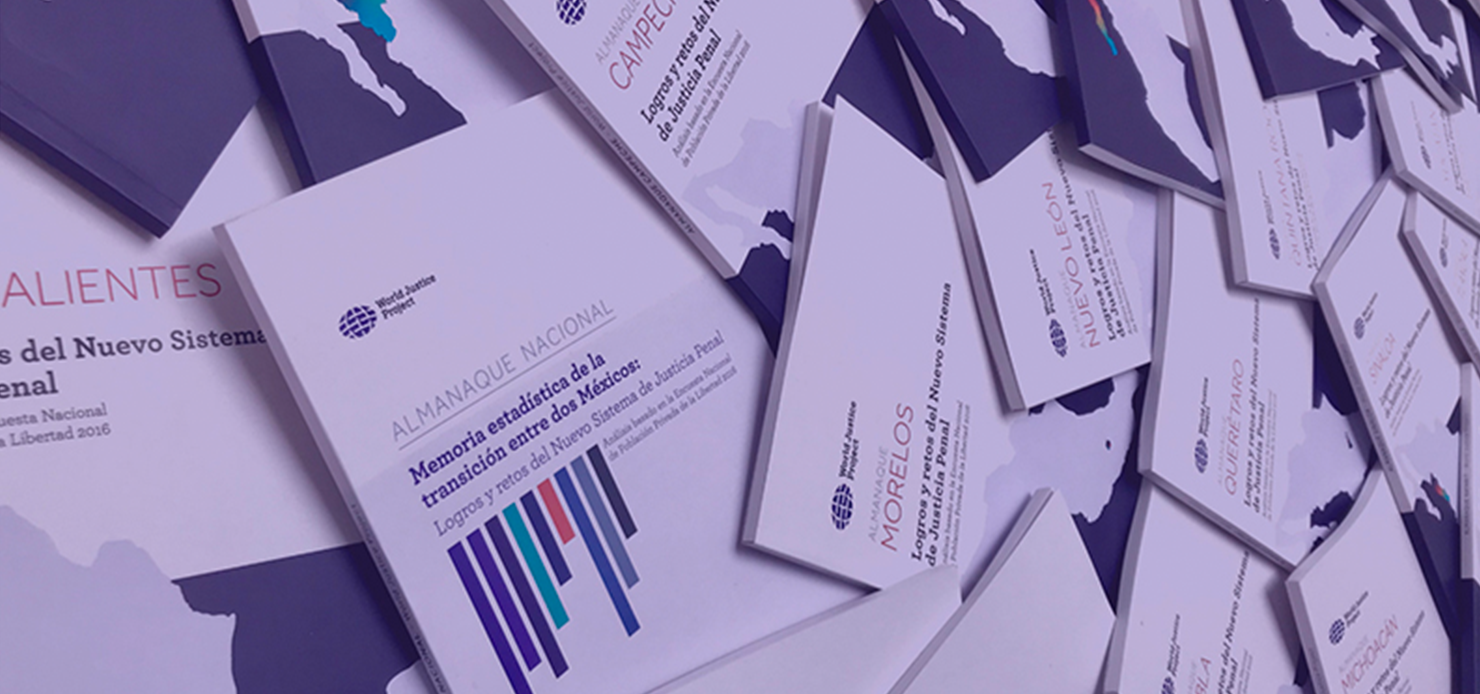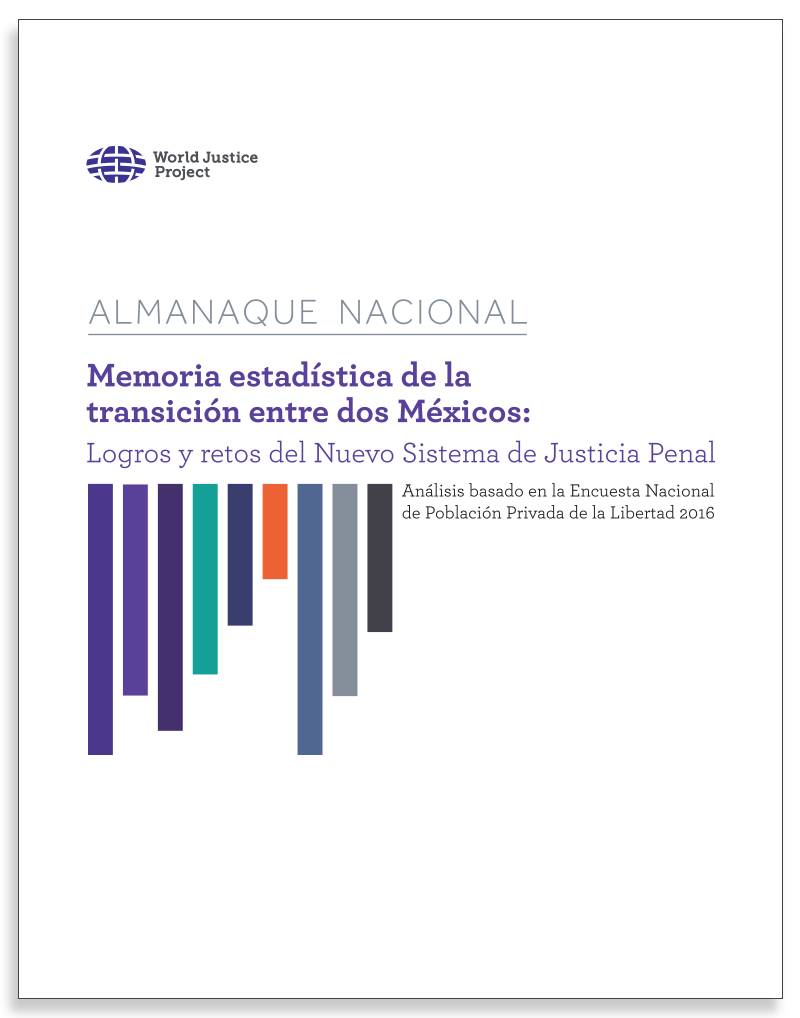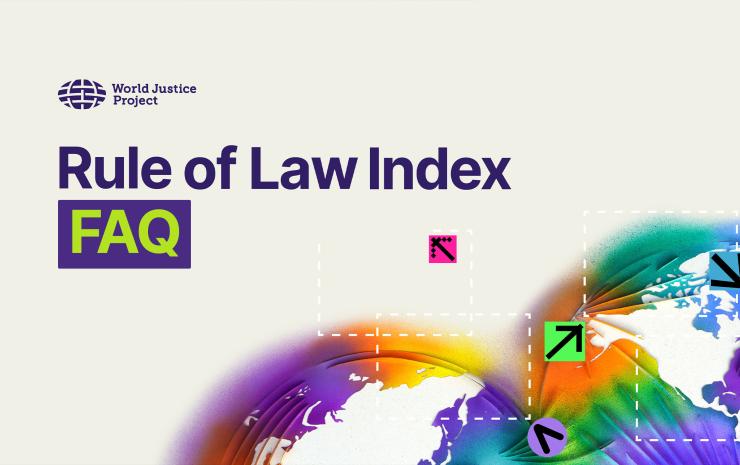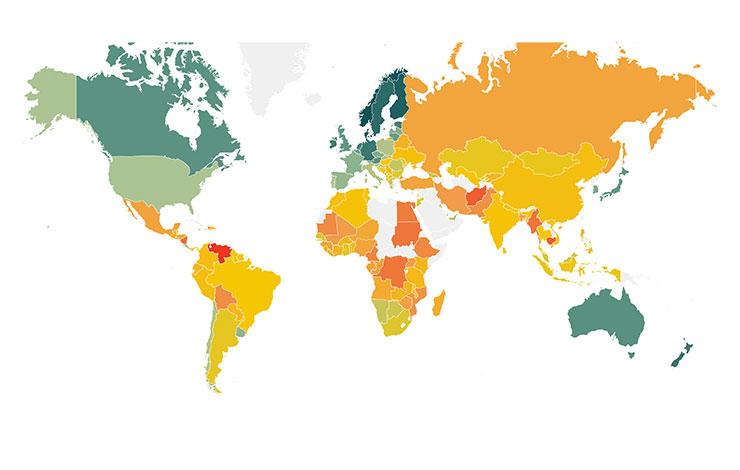

In 2008, the Mexican Federal Congress enacted a constitutional reform that changed the way the criminal justice system operates in Mexico. Almanac: Statistical Memory of the Transition between Two Mexicos - Achievements and Challenges of the New Criminal Justice System is an effort by the World Justice Project (WJP) Mexico team to contribute to greater understanding—through descriptive statistics—of some of the effects of Mexico's New Criminal Justice System (NCJS). The Almanac contrasts the former inquisitorial model to the new adversarial system at a national level using the perspective of persons deprived of liberty. The same contrasting exercise was performed for 31 Mexican states, producing 31 volumes in addition to the national Almanac, published on WJP Mexico's website.
Methodology
 The data comes from the National Survey of Population Deprived of Liberty (ENPOL) 2016, prepared and published by the National Institute of Statistics and Geography (INEGI). ENPOL documents the experiences of more than 58,000 people deprived of liberty aged 18 years and above. Prior to the administration of the survey, INEGI invited several organizations to review the questionnaire. At this stage, the WJP provided suggestions that would allow measurement of the performance of criminal justice system officials.
The data comes from the National Survey of Population Deprived of Liberty (ENPOL) 2016, prepared and published by the National Institute of Statistics and Geography (INEGI). ENPOL documents the experiences of more than 58,000 people deprived of liberty aged 18 years and above. Prior to the administration of the survey, INEGI invited several organizations to review the questionnaire. At this stage, the WJP provided suggestions that would allow measurement of the performance of criminal justice system officials.
Based on state- and unit-level representation, a multidisciplinary team made up of lawyers, economists, and political scientists established a methodology to identify and differentiate between those who were prosecuted and sentenced under the inquisitorial model and those whose criminal proceedings fell under the adversarial system.
Given that implementation of the NCJS developed differently at each state between 2008 and 2016 (implementation phase), the WJP team created a database containing the information from the decrees of transition to the adversarial system published by the state and federal governments. This database was useful to differentiate the cases which fell under the previous system and those which fell under the NCJS in each state, and consequently, identify improvements and standstill per state. This database included the state in which the prosecution occurred, category of crime, date of decree enactment, and effective date.
Through this process, it was possible to identify the type of system under which the 58,127 respondents were detained, indicted and tried. This sample is representative nationally, by state, and by selected prison. The following table shows the groups created on a national basis.
Main Findings
Judicial Process: Judges have better performance in Public Hearings and proceedings are more transparent.
- The NCJS emphasizes the predominant role of the judge during the hearings. Previously, only 16% of people deprived of liberty reported the presence of the judge at their hearings. Under the NCJS, 62% of people said the judge was present in their hearing. At the same time, under the previous system, 52% of defendants thought the clerk was in charge of the hearing, as opposed to 21% under the NCJS.
- It is more common for judges to pay attention during hearings. In the previous system, the judge paid attention in 15% of cases; under the NCJS, attentive judges were reported in 57% of cases.
- Judges explain the charges to defendants more frequently. Previously, 62% of defendants knew their charges. With the NCJS, this increased to 81% of defendants.
- The percentage of people who reported that the court’s decision was clear increased. Under the previous system, 23% of people deprived of liberty reported that the judges were clear when explaining their decisions, this improved to 56% under the NCJS.
- The new system encouraged a greater presence of the parties during hearings. Under the NCJS, 60% of the persons deprived of liberty reported the presence of their defense lawyer. Previously, this percentage was 40%. Also, the presence of a Public Prosecutor at hearings increased with the NCJS to 60%, in contrast to 38% under the previous system.
- Transparency in the judicial process also increased. Under the previous system, only 10% of hearings were videotaped whilst under the NCJS this increased to 63% of cases. Also, under the inquisitorial model 17% of hearings were open to the public, and under the new system, 41% of hearings had an audience.
Public Prosecutor Custody: Greater Presence of the Defense and More Reliable Records
- The NCJS increased the presence of a defense lawyer when an arrested person decided to depose during custody. While 27% of people reported the presence of their defense lawyer in the previous system, under the adversarial criminal system, this proportion increased to 36%.
- The accuracy of the statements rendered during Public Prosecutor custody increased. While previously, only 40% of people deprived of liberty said their statement reflected exactly what they said, under the NCJS, this figure increased to 50%.
Detention: Greater Due Process Adherence and Reduced Use of Force During Detention and Transfer
- Under the New Criminal Justice System, the authorities making arrests explain the cause of the arrest to the detainee more frequently. This practice was reported 45% of the time, while in the previous system only 38% of people deprived of liberty reported that the authorities explained the cause of their detention.
- Similarly, the use of coercion to obtain information during detention was reduced from 77% to 67%.
Conclusions
- The main purpose of the criminal justice system reform was to change the structure of judicial proceedings. The findings reported in the Almanac show that the most significant improvements promoted by the New Criminal Justice System are in the judicial process stage. Nevertheless, the reform had positive spillover effects on the public prosecutor custody stage—and to a lesser extent during detention. It is likely that the improvements achieved in the stage of the judicial process encouraged other actors in the criminal justice system (defense attorneys, prosecutors, and police forces) to modify habits and improve their performance through adherence to due process.
- The findings highlight that the widest room for improvement rest on the police and the Public prosecution.
- Municipal and state police are the groups most involved in crime prevention and prosecution and are therefore institutions that demand priority attention.
- For their part, prosecutors need to strengthen their capacity to investigate complex crimes and reduce their dependence on red-handed cases.
- The WJP team believes that, if police and prosecutors are not strengthened, the advantages of the new criminal justice system will remain unrecognized and the reforms that gave rise to it will be at risk of being reversed.
To learn more about WJP's evaluation of Mexico's new criminal justice system, explore and download Almanac and its 32 volumes at worldjusticeproject.mx/almanaque-enpol16.






